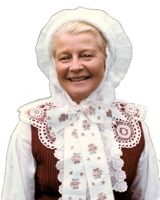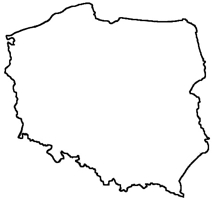
|
The Society of Folk Dance Historians (SFDH)
Dances of Poland
[
Home |
About |
Encyclopedia | CLICK AN IMAGE TO ENLARGE |

|
 First, a few words about Poland in general. Some people think that Poland is part of Eastern Europe. But if you draw a cross on the map of Europe, you can see that Poland is right in the heart of the continent. For centuries, Poland has been a bridge between the cultures of the East and the cultures of the West. In size, it compares to the area of New Mexico. Ninety percent of Poland's territory is a flat or modestly hilly land, with the exception of the Carpathian Mountains in the south, where starts the main river, the Vistula (Wisła). In several places there are still remains of untouched forests with which Poland was once mostly covered.
First, a few words about Poland in general. Some people think that Poland is part of Eastern Europe. But if you draw a cross on the map of Europe, you can see that Poland is right in the heart of the continent. For centuries, Poland has been a bridge between the cultures of the East and the cultures of the West. In size, it compares to the area of New Mexico. Ninety percent of Poland's territory is a flat or modestly hilly land, with the exception of the Carpathian Mountains in the south, where starts the main river, the Vistula (Wisła). In several places there are still remains of untouched forests with which Poland was once mostly covered.
The boundaries of Poland have been in a constant state of change. In 1492, when Columbus was discovering America, Poland – then united with Lithuania – was the largest country in Europe. Unfortunately, soon afterwards she became a victim of constant invasions – by the Russians, Swedes, Turks, and Tartars. Finally, by 1795, partitioned by three neighboring powers – Russia, Prussia and Austria – she completely disappeared from the map of Europe as an independent state. After 123 years of constant struggle for freedom, Poland regained her independence in 1918, at the end of World War I. She remained free until 1939, when World War II put her first under the German and finally under the Communist domination.
Poland, until recently, as mainly an agricultural country, hence her folklore – including arts and crafts, music, and dance – is mainly of rural origin. However, because of her central location at the crossroads of Europe (because of the numerous invasions) and because of her ambition to always look up to the West, to the artistic leadership of France and Italy, there are many foreign influences in all aspects of her culture. This interchange, however, has been a two-way traffic, that means, Poland was not only borrowing from other nations but also contributing to the culture of the world. The best known is Poland's contribution to the domain of music and dance, which have their roots in her folklore. Three Polish national dances, namely the Polonaise, Mazur and Krakowiak, were an inspiration not only for Polish composers (best examples: Chopin's and Paderewski's famous Mazurkas), but also for the composers all over the world. Through the work of these artists, these three dances penetrated also into the international opera and ballet. Besides the domain of music and dance, Poland is also known for her posters, her wallhangings ("kilimy"), her cut-outs ("wycinanki"), and, last but not least, her postal stamps.
 The beginnings of folk dances in Poland reaches back to very distant times. They derive from the tribal dances of the Slavic people inhabiting the area between the Baltic Sea in the north, the Tatra Mountains in the south, the Odra river in the west, and the Bug river in the east. These tribal ceremonies were held in honor of the pagen gods, who watched over the cultivation of crops and over the family matters. With the passing of centuries, however, the dances lost their religious and ceremonial significance becoming a communal social pastime. But even today, they still display traces of the ancient circle made around a god, or feature a leading couple. The most favorite meter, especially in the central, western, and southwestern parts of Poland, is the 3/4 and the 3/8, while the 2/4 and the 4/4 are more popular in the southern and the eastern parts of the country.
The beginnings of folk dances in Poland reaches back to very distant times. They derive from the tribal dances of the Slavic people inhabiting the area between the Baltic Sea in the north, the Tatra Mountains in the south, the Odra river in the west, and the Bug river in the east. These tribal ceremonies were held in honor of the pagen gods, who watched over the cultivation of crops and over the family matters. With the passing of centuries, however, the dances lost their religious and ceremonial significance becoming a communal social pastime. But even today, they still display traces of the ancient circle made around a god, or feature a leading couple. The most favorite meter, especially in the central, western, and southwestern parts of Poland, is the 3/4 and the 3/8, while the 2/4 and the 4/4 are more popular in the southern and the eastern parts of the country.
Polish folk dancing can be divided into two categories: the regional and the national dances.
The different regions began to take shape in pre-historic times. Often, rivers, mountains, thick forests, or swamps defined the boundaries between various regions. In this isolation, special characteristics have developed. However, when the transfer of communication became easier, different regions started to interchange certain cultural features. As a result, with some small differences, lyrics of songs, melodies, and steps had a tendency to wander from place to place. The regional dances are always enhanced by local folk decorations, such as costumes, props, or unique musical instruments. Some dances display remnants of ancient religious or wedding ceremonies. Some imitate the action of cultivating the soil (the dance Kosiarz, "the field mower"), or gestures of a craftsman (the dance Kowol, "the blacksith;" or Szewc, "the shoemaker"), or movements of a field or farm animal (Zającsek, "the hare;" żabiok, "the frog;" Kaczor, "the drake;" or Gołącsek, "the pigeon"). Many were created to a particular song, which still accompanies the dance today. Some, closer to borders, show certain characteristics of neighboring nations: the Germans, the Scandianvians, the Ukrainians, the Czechs, or the Hungarians.
The Polish mountain dances have a special place and almost belong to a category of their own. They were originated under the influence of the folk culture of the Wallachian shepherds. These nomadic tribes, who in the XV and XVI centuries, wandered from the Balkans through the Carpathian Mountains, left the imprint of their pastoral way of life on all the peoples whose lands they had crossed. As a result, the folk culture of the Polish mountaineers, including their work habits, traditional dress, music, and dances, differs a lot from the rest of Poland. It resembles more the folk cultures of the Slovaks, the Romanians<, the Hungarians and the Serbs, especially in the Transylvania region.
The second category are the five national dances of Poland. They are: the stately Polonez, the elegant and fiery Mazur, the martial-like Krakowiak, the romantic and sentimental Kujawiak, and the exhuberant, almost acrobatic Oberek. Interestingly enough, with the exception of the Krakowiak, the music of all of them is in 3/4 time, a meter most beloved by Polish people. These dances are called "national" because, although they are of peasant derivation and originated in a specific folk region of Poland, they spread all over the country and have been taken up by all social stratas. They truly reflect the Polish character. They have many steps and figures, as each region that adopted them added their own variations and style. Through the courts of the magnates they penetrated to the Polish royal castle. In these social groups, they were transformed, polished, enriched with more steps and figures, and used in a more-or-less unified way. Most of the Polish national dances, during the XVIII and the XIX centuries, became fashionable at the main monarchical courts of Europe and at the White House in Washington, D.C.
Nowadays, because of industrial progress, practice on an everyday basis of the old folk ways including the dance is slowly disappearing from the face of the earth everywhere. It is still done in Poland, mainly at weddings, but only in a few isolated spots. However, it is kept alive on a larger scale by numerous folk dance and song ensembles, who try to perpetuate and not let fall into oblivion, the old songs, dances, and music, and the art of making the traditional dress. They also try to preserve the old customs by re-enacting them on the stage. These groups are supported by the Polish government and are formed at various schools and institutions of higher education, as well as at trade unions, rural cooperatives, factories, cultural centers, and civic organizations. Poland also offers help and guidance to numerous Polonia's folk dancing groups which exist abroad. There are two Polish State folk ballet companies: Mazowsze and Ślaşk, who through their stunning stage presentations show to the world the beauty and richness of Polish dance, music, and costumes.
DOCUMENTS
- Ada Dziewanowska, an article.
- Poland, a country.
Used with permission of the author.
Reprinted from the 1983 University of the Pacific (Stockton) Folk Dance Camp syllabus.
This page © 2018 by Ron Houston.
Please do not copy any part of this page without including this copyright notice.
Please do not copy small portions out of context.
Please do not copy large portions without permission from Ron Houston.